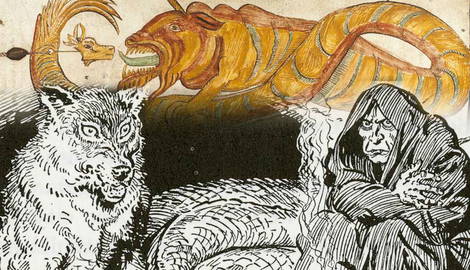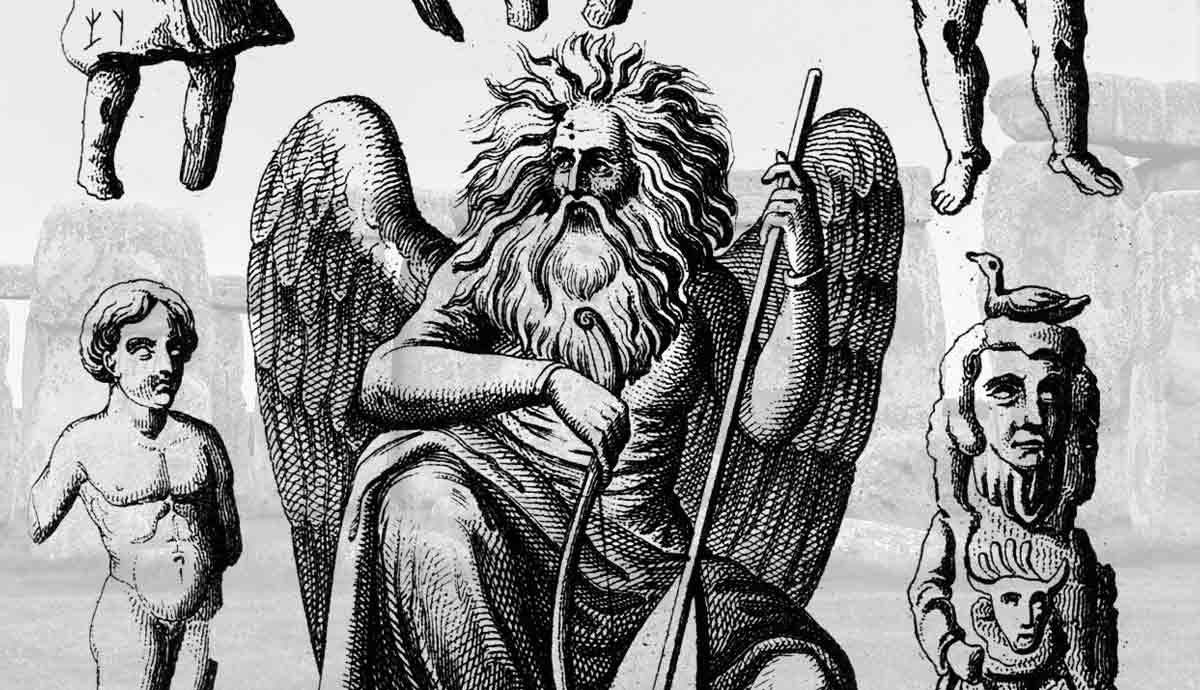
Norse mythology is full of incredible creatures, but perhaps the most threatening is Jormungandr. Also known as the Midgard Serpent, he is a giant serpent that lives in the waters surrounding Midgard. He is so big that he encircles Midgard and holds his own tail in his mouth. A child of Loki, the Norse gods considered Jormungandr a threat. He is portrayed as the great nemesis of Thor and is destined to play an important role in the destruction of the Norse cosmos at Ragnarök. But how did Jormungandr become the monstrous World Serpent, and what role does he play in Norse mythology?
Quick Facts About Jormungandr
| Meaning of Name | Giant serpent, giant river, giant stick, or giant binding. |
| Parents | Trickster god Loki and the giantess Angrboð (Angrboda). |
| Siblings | Fenrir (a giant wolf) and Hel (a giantess). |
| Location | Cast by Odin into the seas in Midgard (earth). |
| Aspect | Grew into a giant sea serpent with razor-sharp teeth. |
Who Is Jormungandr?

In Norse mythology, Jormungandr is one of the children of the trickster giant Loki with the giantess Angrboða. The name “Jormungandr” combines two Old Norse words: “jormun,” which refers to something enormous or supernaturally powerful, and “gandr,” which refers to elongated items, again usually with a supernatural connection.
The name is often interpreted as meaning “giant serpent.” However, it could also be “giant river,” since Jormungandr lives in the waterways, “giant stick,” relating the serpent to Yggdrasil (the world “tree”), or “giant binding,” as he binds the world. This ambiguous naming may be deliberate.

Jormungandr’s mother, the giantess Angrboð (Angrboda), whose name means “bringer of sorrows,” lived in the Ironwood, a dense forest at the edge of Jotunheim, the realm of the giants. There she is said to mate with many giants and produce many offspring, all wolves, who are destined to splatter the world with blood.
With Loki, Angrboda had three children: the great wolf Fenrir, the serpent Jormungandr, and the giantess Hel. According to chapter 24 of the Prose Edda’s section Gylfaginning (“The Beguiling of Gylfi”), when the gods heard that the offspring of such a monstrous union were being nourished in Jotunheim, Odin ordered them brought to Asgard. He knew from a prophecy that these children would bring great misfortune to them all.
What Happened to Jormungandr?

After evaluating them, Odin decided to place each somewhere in the world where they could do the least harm. According to the Prose Edda, Odin tossed Jormungandr, while still a small serpent, into the waters surrounding Midgard, the world of men.
However, this decision led to dire consequences. Indeed, in this great body of water, the sea serpent grew to such an enormous size that he could encircle the entire world and hold his own tail in his mouth. The huge monster’s mouth is full of razor-sharp teeth and is big enough to swallow a giant whole.

Due to his enormous size, Jormungandr became an inseparable part of the ecosystem. This is revealed in the story of Thor‘s visit to the home of Utgard-Loki in Jotunheim. There, the immensely strong god of thunder is tricked into trying to pick up what looks like a normal cat. To his surprise, he can only lift one paw a few inches off the ground.
The giant Utgard-Loki later reveals to Thor that this was an illusion and that the cat was actually the serpent Jörmungandr. Even the small amount that he was able to lift the serpent caused major disruption in the natural world.
Thor Catches Jormungandr

Chronologically, in Norse mythology, Jormungandr next appears as a major player in the story of Thor’s fishing trip. Thor went to the home of the giant Hymir to borrow a cauldron big enough to brew mead for all the gods. While there, Hymir invited Thor to eat with him. However, he was shocked when the god, who was known for his enormous appetite, devoured two entire oxen in a single sitting.
Unwilling to kill more of his animals to feed the god, Hymir informed Thor that they would have to fish for the next day’s meal. The thoughtless god killed the rest of Hymir’s oxen to use their heads as bait, much to the giant’s distress.
The two rowed out to sea and caught many excellent fish and even two whales with the oxen-head bait. However, Thor was unsatisfied, demanding that Hymir continue to row further out, where they would find bigger fish.

Eventually, Thor caught something so enormous on his line that it almost destabilized the boat. Hymir was very concerned about what this could be. He knew that they were far enough out to encounter the Midgard Serpent, and that this was the only being in the water that could challenge Thor’s strength. Hymir warned the god, but he refused to heed the warning.
Eventually, Thor pulled Jormungandr up, and its head broke the surface of the water. The great serpent started spitting venom, and Thor began to hit the serpent in the head with his fists. Hymir was so terrified by this spectacle that he cut Thor’s fishing line, letting the serpent sink back into the depths of the water.
This story is seen as a precursor to Ragnarök. It shows that Thor has no fear of fate and no concern for the consequences of his actions.
What Is Jormungandr’s Role at Ragnarök?

Ragnarök is a prophecy about the death of the gods and the end of the world that a Volva seeress revealed to Odin. According to the prophecy, the world will end when a series of earthquakes and other catastrophes shake the earth. This will allow Loki and Fenrir, who have both been imprisoned by the gods at this point, to break free of their chains and lead an offensive against Asgard.
Ragnarök will also be preceded by three endless winters in Midgard. The cold will make Jormungandr uncomfortable in his waters, and he will finally emerge onto the land. There, he will join the final battle. He will spew huge amounts of toxic venom into the air, poisoning the world.

Thor is destined to hunt down and fight Jormungandr. He will kill the serpent with his mighty hammer, Mjolnir. But Jormungandr will spew so much venom onto Thor that he will take only nine paces before dropping dead himself.
Meanwhile, Jormungandr’s brother, the great wolf Fenrir, will kill Odin before being killed by Odin’s son Vidarr. Loki and the Aesir god Heimdall will also fight to their mutual destruction.
The toxic atmosphere caused by Jormungandr will contribute to the overall destruction of existence. The world will sink back into the waters of chaos from which it emerged.
Jormungandr in Norse Art

While Jormungandr is important in the overall arc of Norse mythology, he is not often mentioned in the surviving Norse myths. However, the serpent is a popular motif in Norse art.
The story of Thor’s fishing trip appears on at least three surviving runestones. This reinforces the idea that this story is not just an anecdotal account of the god’s adventures. It must have a deeper meaning around testing fate and the arrival of Ragnarök.
The Altuna Runestone from Uppland in Sweden was probably erected in the 11th century and appears to show the moment when Thor has Jormungandr on his fishing line and is beating him.
Similar images appear on one of the Andre image stones from Gotland in Sweden, which dates to the 8th or 9th century. It appears again on the Hordum stone from northern Denmark, and on the 9th-century Gosforth Stone from England.
Serpents in Norse Art

Serpents are also a consistent theme in Viking designs and decorations. While these cannot be specifically identified as Jormungandr, as the most famous Norse serpent, they are likely to reference him.
On the other hand, there are other serpents in Norse mythology. Nighogg lives among the roots of Yggdrasil and gnaws on the tree. While he is often described as a dragon, the Vikings did not distinguish between serpents and dragons.
According to one description of Helheim, which is probably based on later Christian ideas, there is a special place called Nastrond for the wickedest dead. Nidhogg and other serpents feed on these wretched souls.

When Loki is finally imprisoned for his crimes, the gods also place a venomous snake over his body to painfully drip toxic venom onto his skin. In many examples of Viking art, snakes are used in a stylistic way to create patterns. Their long bodies curl around themselves and create elaborate patterns.
Serpents were also often depicted entangled around four-legged animals. On the 10th-century runestone of Harald Bluetooth from Jelling in Denmark, a lion is entangled by a snake. A similar scene can be seen at the 11th-century Urnes Stave church in Norway. This recurring motif suggests that snakes, in general, and Jormungandr in particular, carried specific connotations in the Viking world, although they are difficult to interpret today.










